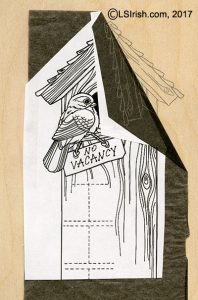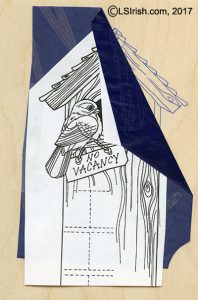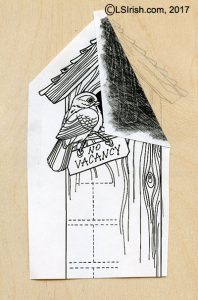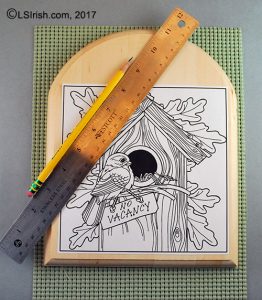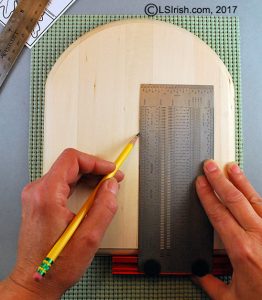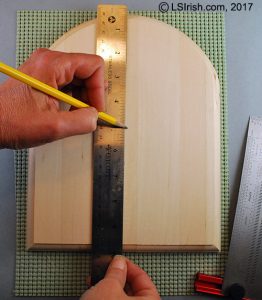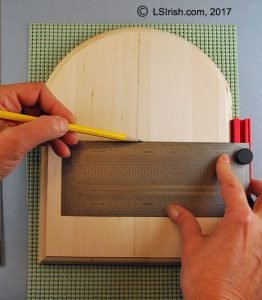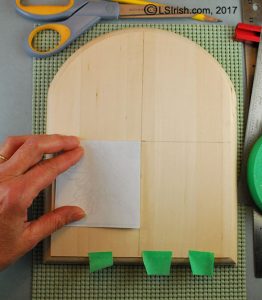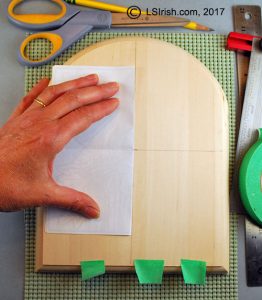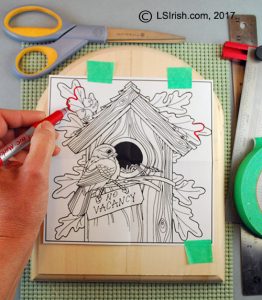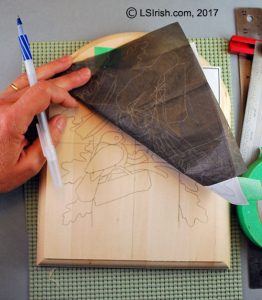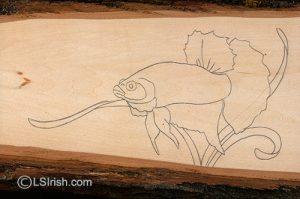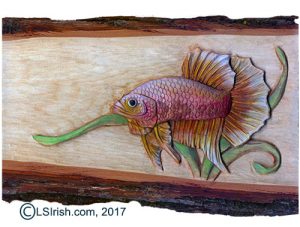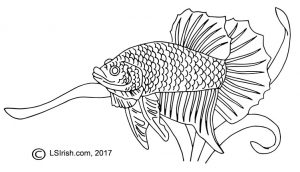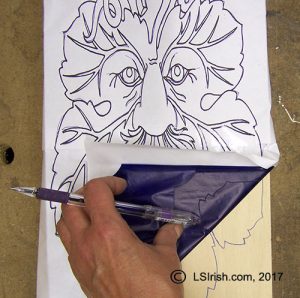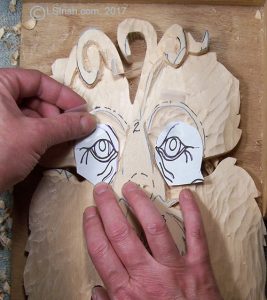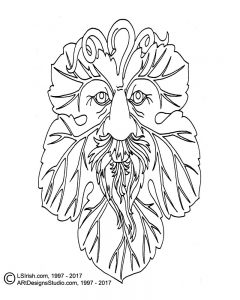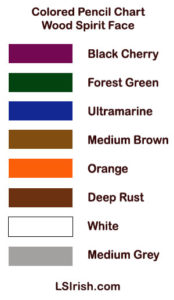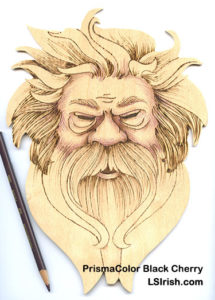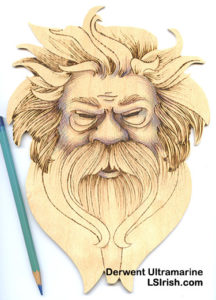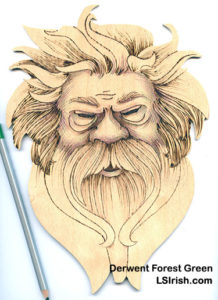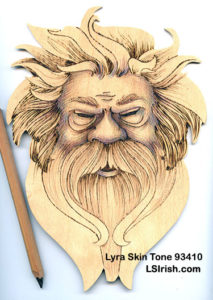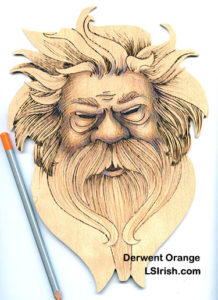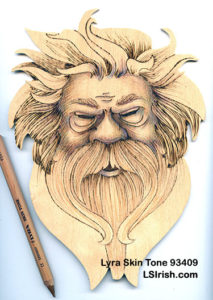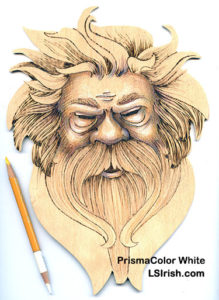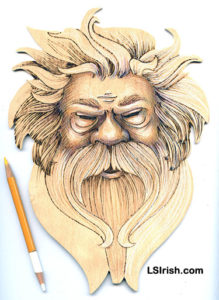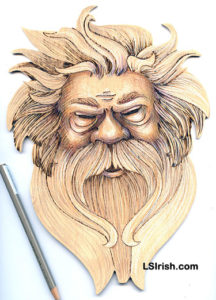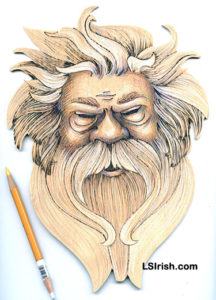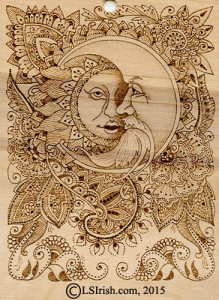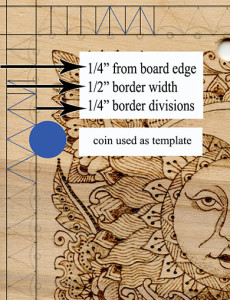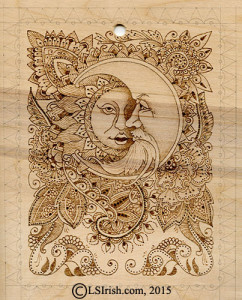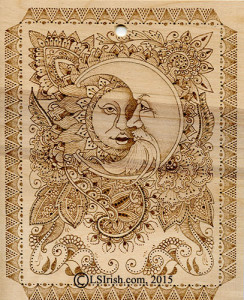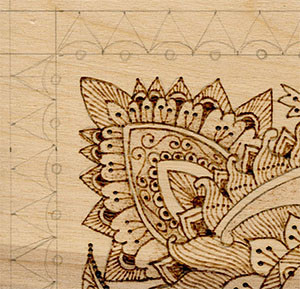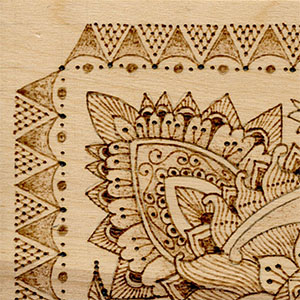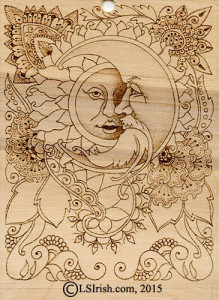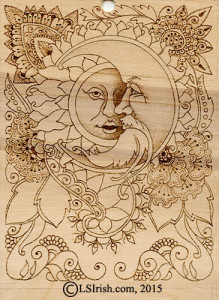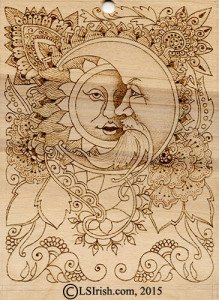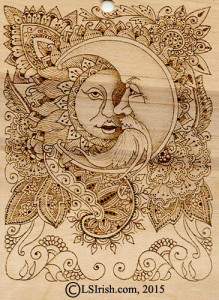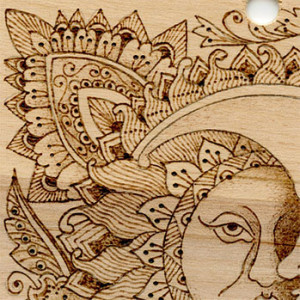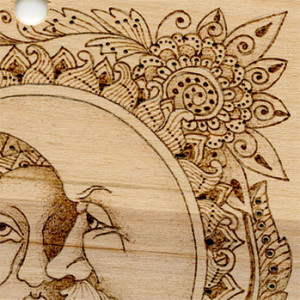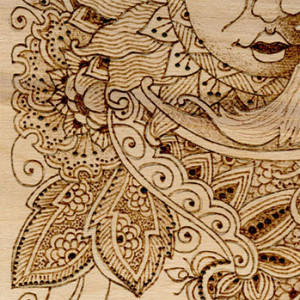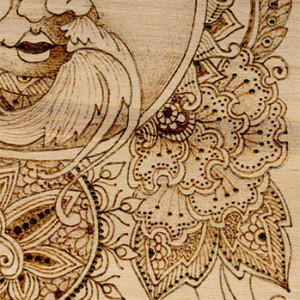Pyrography Landscape Backgrounds
In Pyrography landscape burnings your background determines the time of year, the time of day, and the weather conditions of your scene. Landscapes are worked from the farthest element in the scene to the nearest, foreground elements, which allows you to overlap foreground burnings over the paler background areas. So those first few burning steps are extremely important in setting the stage for your main element, as a barn or church.
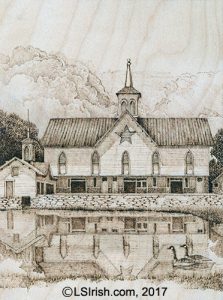 Let’s look at a few examples of how you can create both seasonal and weather conditions in your landscape pyrography burnings.
Let’s look at a few examples of how you can create both seasonal and weather conditions in your landscape pyrography burnings.
The wood burning, shown right, is from my book, Great Book of Wood Burning, and is titled The Star Barn. Three strong elements set the time of day – the thick, low storm clouds in the farthest background point, the extremely dark trees just behind the barn on both sides of the barn, and the wide shadows of the roof overhang on the barn.
The roof barn overhang shadow is even on both sides of the face of the barn. At the peak of the roof the there is almost as much shadow on the right side as on the left. This places the sun in the 12 to 1 o’clock position.
All three elements tell you that this scene is mid-afternoon, high summer, and that the thunderstorms are eminent. This scene has atmosphere, weather, and tells a story about the conditions surrounding the landscape subject.
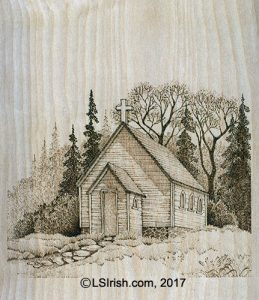 The Country Church, also from the Great Book of Wood Burning, does not use clouds to suggest the time of year. Instead the light speckling of leaves on the two deciduous trees behind the barn and the lack of fallen leaves on the ground set the time of year as early spring.
The Country Church, also from the Great Book of Wood Burning, does not use clouds to suggest the time of year. Instead the light speckling of leaves on the two deciduous trees behind the barn and the lack of fallen leaves on the ground set the time of year as early spring.
The top edge of the line of background trees has been packed with more burning strokes than the lower layer of the tree area, giving the impression that the leaves are just emerging at the tips of the branches. The high grass – un-mowed – in the foreground shows the new spring growth. Long shadows under the roof overhang are shown on the right side of the face of the church which places the sun in the 2 to 3 o’clock position in the sky.
With a little planning and forethought you can take either of these two landscape pyrography scenes into a different time of year, time of day, or weather conditions. Let’s see how!
Clear, sunny day setting
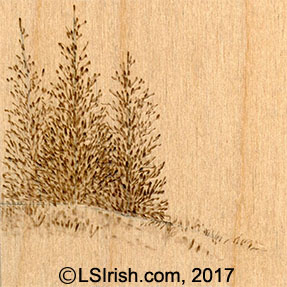 A clear, sunny day has few or no clouds in the sky. If you chose to add clouds they hand high in the sky and display both the top and bottom edges of the cloud. Clear days create a deeper tonal value in the background elements as well as casting very crisp shadows.
A clear, sunny day has few or no clouds in the sky. If you chose to add clouds they hand high in the sky and display both the top and bottom edges of the cloud. Clear days create a deeper tonal value in the background elements as well as casting very crisp shadows.
Clear, sunny sky backgrounds allow you to burn the background trees, mountains, or farm fields in varying tonal values which separates one area of the background from another. In my sample you can see three distinct trees with the middle tree in front of the other two trees.
Misty or foggy morning
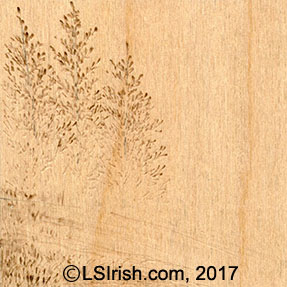 Early morning fog is simply a cloud that has settled against the earth. That cloud is full of fine water particles that obscure your vision. The lower to the ground the cloud lies the less you can see of your background trees or fence line.
Early morning fog is simply a cloud that has settled against the earth. That cloud is full of fine water particles that obscure your vision. The lower to the ground the cloud lies the less you can see of your background trees or fence line.
Note in this sample burn that while the tips of the pines are burned at a pale-medium temperature setting, the lowest portions of the pines have little or no burning strokes. The very bottom of the pines are not burned, which implies the heaviest area of fog the lies along the edge of the hill.
The slight slope of the ground is further implied by the diagonal shading strokes that is worked from the left to the right, under the pines. As those shading strokes flow to the right they become paler, implying that the fog is becoming thicker the farther down the hill it lies.
Early evening, sunset
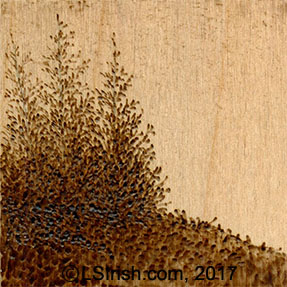 As the sun slips behind the horizon of your scene it creates a graduated variation in the sky with the brightest, or palest area along the horizon line and with the sky becoming darker as the sky nears the top of your pattern. Note that the palest, un-burned point, in this sample is in the lower right corner, just above the grassy slope.
As the sun slips behind the horizon of your scene it creates a graduated variation in the sky with the brightest, or palest area along the horizon line and with the sky becoming darker as the sky nears the top of your pattern. Note that the palest, un-burned point, in this sample is in the lower right corner, just above the grassy slope.
Because the light is coming from behind the pines and at a low angle to the pines, all of the pines on our side of the scene are in shadow.
In sunset scenes, because the tree line is in shadow, the pines are burned as if they were one tree and not three trees. The deep shadowing obscures the individuality of the the pines.
Winter snow
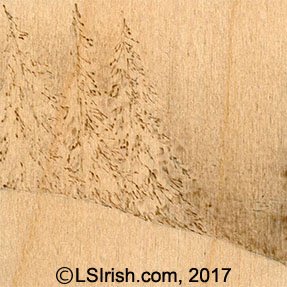 Snow scenes can seem hard to burn because of all of the pale, white areas in the scene. So instead of burning the snow on the background trees, you burn the atmosphere around those background trees.
Snow scenes can seem hard to burn because of all of the pale, white areas in the scene. So instead of burning the snow on the background trees, you burn the atmosphere around those background trees.
Snow clouds are just like fog and mist. They hang low against the ground and are more dense the closer to the ground they lie. This is because each small snow flake casts a small shadow – the higher the number of flakes, the more small shadows you have.
For this sample there is no burning of the grassy slope because it is fully covered with snow. The pines have only a few strokes, at the tip of the branches, where the branches touch the ground, and at the top of the pines. This leaves the larger areas inside of each pine un-burned, implying that the snow is sticking to the branches.
The background atmosphere – the snow cloud – is burned in a deeper tonal value and becomes paler the higher it reaches into the sky. This cloud shading also helps to emphasize the snow on the pine branches, giving a darker tonal value to where the sky shows between the pine branches.
Work in Progress
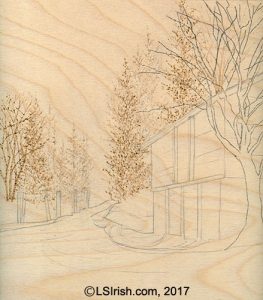 The current project on my table is a landscape scene of an old bank barn that lies right at the edge of a dirt road.
The current project on my table is a landscape scene of an old bank barn that lies right at the edge of a dirt road.
I have the first step of this project completed, which is the farthest background elements of the distant trees on the left side and the trees on the right that fall behind the barn.
Because the deciduous trees on both sides of the background only have their trunks and branches burned I can at this point in the work chose to make this either an early morning scene or a snow scene.
How I treat the land lying under both of these tree lines will determine the time of day and the weather conditions.
Here are my choices:
If I do not burn the land area, this will become a snow scene and I will leave the deciduous trees without leaves.
If I chose to lightly create a tonal value shading in the land this will become an early morning scene. I can decide the time of year by how thickly I fill the tops of the deciduous trees with leaves – a thin layer of leaves means springtime, a thicker layer of leaves means summer, and a medium layer of leaves and the impression of fallen leaves on the ground implies an autumn setting.
If I chose to add heavy shadows, worked in a medium tonal value, under the trees I can create a specific time of day.
Check back tomorrow to see what I chose to do!
Practice pattern
While you wait for the next posting you might enjoy doing a test sample for weather, time of day, and time of year yourself. On a birch, poplar, or basswood board create a four square grid with each square measuring 3″ along the sides.
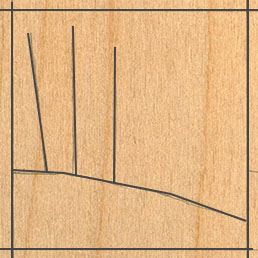 The pattern for these background trees is simply the line at the top of the grassy slope, and a line for each central trunk of each tree. Because the trees are created using a short, quick stroke with either the loop-tip or ball-tip pen, you only need a few lines to guide you as to where you will burn your pines.
The pattern for these background trees is simply the line at the top of the grassy slope, and a line for each central trunk of each tree. Because the trees are created using a short, quick stroke with either the loop-tip or ball-tip pen, you only need a few lines to guide you as to where you will burn your pines.
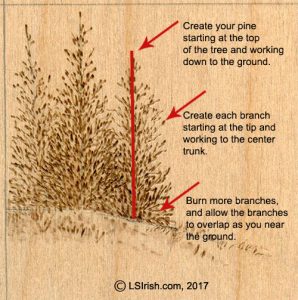 Pines are burned from the top of the tree down to the ground line and from the outer tips of each branch towards the central trunk of the tree. Place the branches randomly along the trunk, allow open air spaces between branches.
Pines are burned from the top of the tree down to the ground line and from the outer tips of each branch towards the central trunk of the tree. Place the branches randomly along the trunk, allow open air spaces between branches.
As you near the trunk you will have branches overlapping which will create the natural deepening of the tonal value through the center of the tree.
Follow the four weather samples, above, to practice how you can determine and control the time of day, time of year, and weather conditions in any landscape.
OK … see you tomorrow with an up-date on my WIP barn landscape burning.
~ Lora
